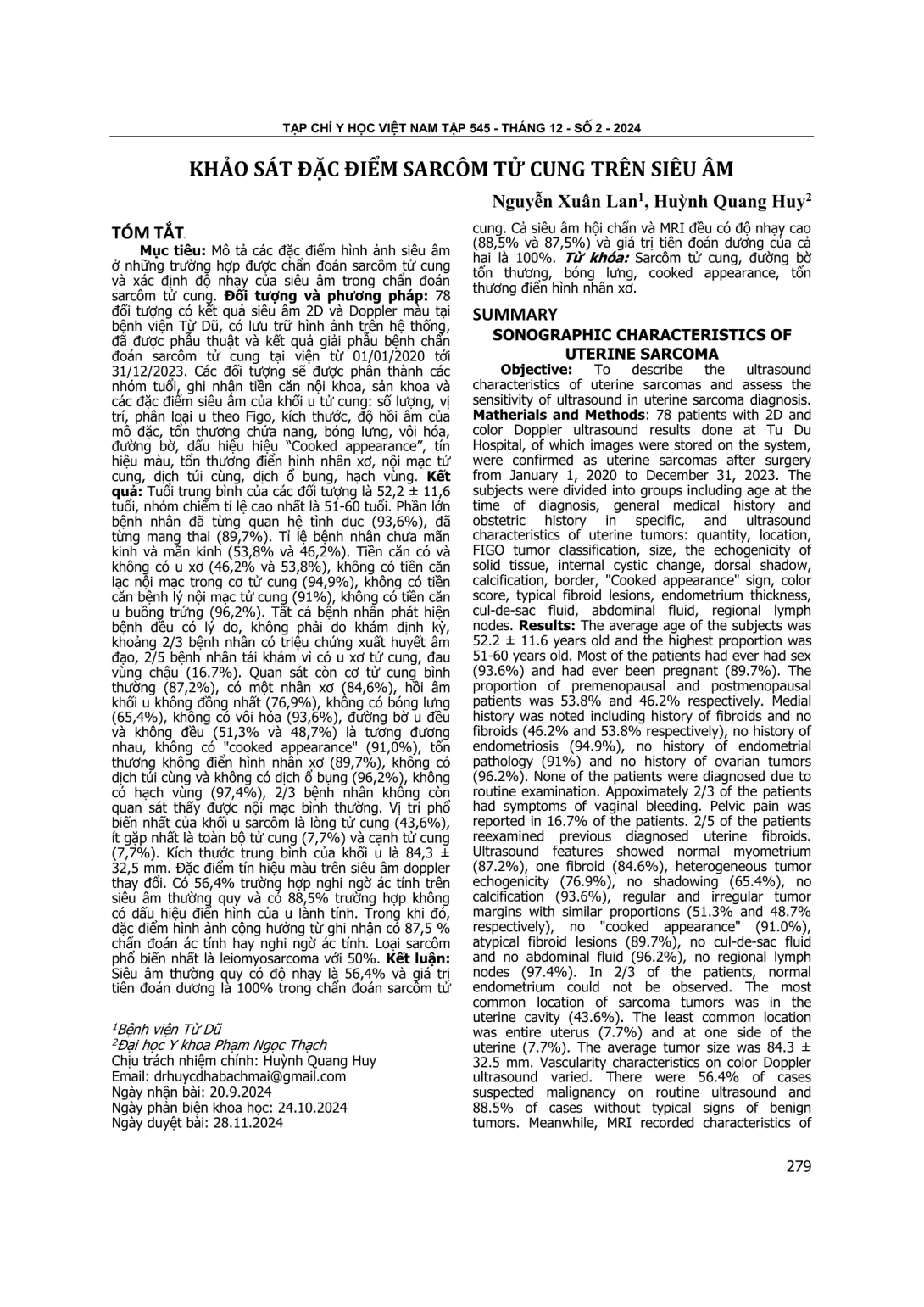
Mô tả các đặc điểm hình ảnh siêu âm ở những trường hợp được chẩn đoán sarcôm tử cung và xác định độ nhạy của siêu âm trong chẩn đoán sarcôm tử cung. Đối tượng và phương pháp: 78 đối tượng có kết quả siêu âm 2D và Doppler màu tại bệnh viện Từ Dũ, có lưu trữ hình ảnh trên hệ thống, đã được phẫu thuật và kết quả giải phẫu bệnh chẩn đoán sarcôm tử cung tại viện từ 01/01/2020 tới 31/12/2023. Các đối tượng sẽ được phân thành các nhóm tuổi, ghi nhận tiền căn nội khoa, sản khoa và các đặc điểm siêu âm của khối u tử cung: số lượng, vị trí, phân loại u theo Figo, kích thước, độ hồi âm của mô đặc, tổn thương chứa nang, bóng lưng, vôi hóa, đường bờ, dấu hiệu hiệu “Cooked appearance”, tín hiệu màu, tổn thương điển hình nhân xơ, nội mạc tử cung, dịch túi cùng, dịch ổ bụng, hạch vùng. Kết quả: Tuổi trung bình của các đối tượng là 52,2 ± 11,6 tuổi, nhóm chiếm tỉ lệ cao nhất là 51-60 tuổi. Phần lớn bệnh nhân đã từng quan hệ tình dục (93,6%), đã từng mang thai (89,7%). Tỉ lệ bệnh nhân chưa mãn kinh và mãn kinh (53,8% và 46,2%). Tiền căn có và không có u xơ (46,2% và 53,8%), không có tiền căn lạc nội mạc trong cơ tử cung (94,9%), không có tiền căn bệnh lý nội mạc tử cung (91%), không có tiền căn u buồng trứng (96,2%). Tất cả bệnh nhân phát hiện bệnh đều có lý do, không phải do khám định kỳ, khoảng 2/3 bệnh nhân có triệu chứng xuất huyết âm đạo, 2/5 bệnh nhân tái khám vì có u xơ tử cung, đau vùng chậu (16.7%). Quan sát còn cơ tử cung bình thường (87,2%), có một nhân xơ (84,6%), hồi âm khối u không đồng nhất (76,9%), không có bóng lưng (65,4%), không có vôi hóa (93,6%), đường bờ u đều và không đều (51,3% và 48,7%) là tương đương nhau, không có "cooked appearance" (91,0%), tổn thương không điển hình nhân xơ (89,7%), không có dịch túi cùng và không có dịch ổ bụng (96,2%), không có hạch vùng (97,4%), 2/3 bệnh nhân không còn quan sát thấy được nội mạc bình thường. Vị trí phổ biến nhất của khối u sarcôm là lòng tử cung (43,6%), ít gặp nhất là toàn bộ tử cung (7,7%) và cạnh tử cung (7,7%). Kích thước trung bình của khối u là 84,3 ± 32,5 mm. Đặc điểm tín hiệu màu trên siêu âm doppler thay đổi. Có 56,4% trường hợp nghi ngờ ác tính trên siêu âm thường quy và có 88,5% trường hợp không có dấu hiệu điển hình của u lành tính. Trong khi đó, đặc điểm hình ảnh cộng hưởng từ ghi nhận có 87,5 % chẩn đoán ác tính hay nghi ngờ ác tính. Loại sarcôm phổ biến nhất là leiomyosarcoma với 50%. Kết luận: Siêu âm thường quy có độ nhạy là 56,4% và giá trị tiên đoán dương là 100% trong chẩn đoán sarcôm tử cung. Cả siêu âm hội chẩn và MRI đều có độ nhạy cao (88,5% và 87,5%) và giá trị tiên đoán dương của cả hai là 100%.
To describe the ultrasound characteristics of uterine sarcomas and assess the sensitivity of ultrasound in uterine sarcoma diagnosis. Matherials and Methods: 78 patients with 2D and color Doppler ultrasound results done at Tu Du Hospital, of which images were stored on the system, were confirmed as uterine sarcomas after surgery from January 1, 2020 to December 31, 2023. The subjects were divided into groups including age at the time of diagnosis, general medical history and obstetric history in specific, and ultrasound characteristics of uterine tumors: quantity, location, FIGO tumor classification, size, the echogenicity of solid tissue, internal cystic change, dorsal shadow, calcification, border, "Cooked appearance" sign, color score, typical fibroid lesions, endometrium thickness, cul-de-sac fluid, abdominal fluid, regional lymph nodes. Results: The average age of the subjects was 52.2 ± 11.6 years old and the highest proportion was 51-60 years old. Most of the patients had ever had sex (93.6%) and had ever been pregnant (89.7%). The proportion of premenopausal and postmenopausal patients was 53.8% and 46.2% respectively. Medial history was noted including history of fibroids and no fibroids (46.2% and 53.8% respectively), no history of endometriosis (94.9%), no history of endometrial pathology (91%) and no history of ovarian tumors (96.2%). None of the patients were diagnosed due to routine examination. Appoximately 2/3 of the patients had symptoms of vaginal bleeding. Pelvic pain was reported in 16.7% of the patients. 2/5 of the patients reexamined previous diagnosed uterine fibroids. Ultrasound features showed normal myometrium (87.2%), one fibroid (84.6%), heterogeneous tumor echogenicity (76.9%), no shadowing (65.4%), no calcification (93.6%), regular and irregular tumor margins with similar proportions (51.3% and 48.7% respectively), no "cooked appearance" (91.0%), atypical fibroid lesions (89.7%), no cul-de-sac fluid and no abdominal fluid (96.2%), no regional lymph nodes (97.4%). In 2/3 of the patients, normal endometrium could not be observed. The most common location of sarcoma tumors was in the uterine cavity (43.6%). The least common location was entire uterus (7.7%) and at one side of the uterine (7.7%). The average tumor size was 84.3 ± 32.5 mm. Vascularity characteristics on color Doppler ultrasound varied. There were 56.4% of cases suspected malignancy on routine ultrasound and 88.5% of cases without typical signs of benign tumors. Meanwhile, MRI recorded characteristics of malignancy or suspicious malignancy in 87.5% of cases. The most common type of sarcoma was leiomyosarcoma confirmed in 50% of the patients. Conclusion: Routine ultrasound had a sensitivity of 56.4% and a positive predictive value of 100% in our research. Both ultrasound consultation and MRI had a high sensitivity (88.5% and 87.5% respectively) and a positive predictive value of 100%.
- Đăng nhập để gửi ý kiến
